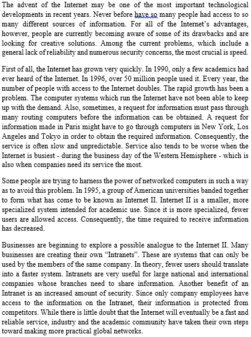GIẢI THÍCH LÍ DO GIÚP MÌNH NỮA NHÉ
Read the following passage and mark the letter A, B, C or D to indicate the correct answer to each of the questions. Education System of Vietnam in the past Because of 1,000 years under the control of China, there were no records which indicated a formal education system in Vietnam. In 939, Emperor Ngo Quyen expelled the Chinese invaders and declared Vietnamese independence. But the first two dynasties, Ngo and Dinh, did not last so long, and were busy with the national defense, so the education was just in pagodas. Ly Cong Uan, the founder king of the Ly dynasty had been educated in a pagoda. To the Ly dynasty, the fundamental educational system was officially improved. King Ly Thanh Tong established the Temple of Literature at the ancient Capital of Thang Long to encourage people to appreciate the education. In 1075, the first exam was done by the order of King Ly Nhan Tong to select scholars for the office and the later year, 1076, the Imperial Academy, the first university in Vietnams history, was set up for the education of sons of royalty and other high-ranking officials. There were also many private classes taught by prominent scholars such as Chu Van An, Le Quy Don, Nguyen Binh Khiem, Phung Khac Khoan, Vo Truong Toan... The students would only study literature and ancient history of China, and Vietnam for entirety of their schooling. Later on, the Public Administration curriculum was finally added to the programme. When the Ho Royal family ruled the country, students were taught simple mathematics. From 1918 to 1945, Vietnams education programme adopted the western education system with three levels: elementary, high school, and college. At all levels, from 1945 the Vietnamese national language is officially used. Students have the opportunity to learn literature, history, philosophy, law, science, math, medicine and other languages.
28. In the past, students mostly learned _________.
A. the ways to rule the country
B. literature and ancient history
C. public administration
D. science subjects and mathematics
29. In the 10th century, parents _________.
A. could send their children to pagodas to have some schooling
B. didnt want their children go to school under the control of China
C. could let their children have a formal education
D. were too busy to send their children to school
30. All of the following were done during the Ly dynasty EXCEPT that _________.
A. the Imperial Academy was established in 1076
B. King Ly Nhan Tong ordered to hold the first exam to select scholars
C. all good students could go to the Imperial Academy
D. King Ly Thanh Tong established the Temple of Literature
31. From 1918 to 1945, Vietnams education system _________.
A. had a wide range of subjects at college
B. officially used the Vietnamese national language
C. was divided into three levels
D. was the same as the western education system
32. We can infer from the passage that _________.
A. mathematics was highly developed during the Ho dynasty
B. the private classes replaced the Imperial Academy
C. education was highly appreciated during the dynasties
D. the prominent scholars such as Le Quy Don couldnt teach at the Imperial Academy


29C
Dẫn chứng: But the first two dynasties Ngo and Dinh did not last so long, and were busy with the national defense, so the education was just in pagodas
30A
Dẫn chứng: All good students could go to the Imperial Academy
31D
Dẫn chứng: The students would only study literature...their schooling
32B
Dẫn chứng: education was highly appreciated during the dynasties
33B
Dẫn chứng: from 1918 to 1945, Viet Nam's education programme adopted...college